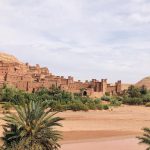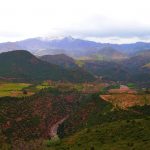Located about 40 minutes north of Meknes in the foothills of Zerhoun Massif, Volubilis takes its name from the Berber word Oualili, the name for the colorful flower of the convolvulus, a plant to be found in abundance in the region. Included on the UNESCO World Heritage list in 1997, Volubilis is Morocco’s largest archaeological site, with a full 18 hectares open to the public. The site owes its fame to the countless mosaics that decorate its ancient dwellings.
The visitor who makes his way to Volubilis sees the ruins of this old Roman town from afar. While it is true that the most visible monuments date from the first to third centuries a.d., when the Romans occupied Volubilis (then called Oualili, later transformed into Volubilis), a Mauretanian Berber village of roughly-built houses had already existed there for several centuries.
Its Ancient History
Volubilis is an ancient Roman and Berber city. It developed in the 3rd century as a Berber settlement and then became a Roman settlement in the 1st century AD and onward. In the late 2nd century there were 20,000 inhabitants living there, which was a large number for this type of Roman city. These people lived off of olive production, making oil from their olives. They also grew grain and raised different types of animals. During this time, it was known as one of the richest small cities in this area. Volubilis is known for its large mosaic floors that are still intact today. The ruins stayed completely together until an earthquake hit them in the 18th century. In the 19th century, it was officially named – the ancient city of Volubilis.
Volubilis was the Roman Empire’s most remote and far-flung base. It represented – and was, literally – the end of the imperial road, having reached across France and Spain and then down from Tangier, and despite successive emperors’ dreams of “penetrating the Atlas”, the southern Berber tribes were never effectively subdued. In fact, the direct Roman rule here lasted a little over two centuries – the garrison withdrew early, in 285 AD, to ease pressure elsewhere. But the town must have taken much of its present form well before the official annexation of the Kingdom of Mauretania by Emperor Claudius in 40 AD. Tablets found on the site, inscribed in Punic, show a significant Carthaginian trading presence in the third century BC, and prior to colonization it was the western capital of a heavily Romanized, but semi-autonomous, Berber kingdom that reached into northern Algeria and Tunisia. After the Romans left, Volubilis experienced a very gradual change. Latin was still spoken in the seventh century by the local population of Berbers, Greeks, Syrians, and Jews; Christian churches survived until the coming of Islam, and the city itself remained active well into the seventeenth century, when its marble was carried away by slaves for the building of Moulay Ismail’s Meknes.
What you see today, well excavated and maintained, are largely the ruins of second- and third-century AD buildings – impressive and affluent creations from its period as a colonial provincial capital.
Now we jump into 1997, UNESCO listed the area as a World Heritage Site. In 2000, another area was discovered by INSAP and said to be the headquarters of Idriss I. Many of the objects found have been taken to the Archeological Museum in Rabat. There is also a small Museum on this site that you can visit.
The archaeological site of Volubilis
Volubilis is now a UNESCO World Heritage site, and one of the largest ruins in Africa. The site now rests on a plain at an altitude of 1300 feet. On both of its sides, it is bordered by two different rivers: Fertassa and Oued Khomane. Visitors will find fertile land and beautiful gardens, a stark contrast to some of Morocco’s barren desert landscapes in the south.
Demolition of the city began when marble from the buildings and monuments were taken to provide materials for the construction of the royal palaces of Moulay Ismail in Meknes.
Though grand columns and other remnants of structures and buildings remain, the true attraction of Volubilis is the exquisite tile mosaics covering the floors. Many previous visitors suggest keeping your eyes on the ground to discover the true beauty of the place. In all, there are about 30 mosaics on the site, some fenced in for preservation and protection from wear and tear by visitors. In addition to the stunning works of mosaic art on the ground, some buildings and monuments make for awe-inspiring, picture-worthy sites as well. The Victory Arch, built-in 217 to honor the Roman Emperor Caracalla, faces the main route. Though still missing its original bronze chariot, the arch underwent restoration in 1962. Volubilis, like many Roman towns, included a forum with impressive grand columns that are still standing today. The town once had many stately homes, dozens of bakeries and over 100 oil presses. Had the demolition for materials not occurred, Morocco could boast of having one of the best-preserved Roman ruin anywhere in the world. Though no longer an imposing city, and the ruin having been reduced to a 2500 x 1900 foot area it is still worth a day trip to view the extraordinary sites left behind. Visiting from the. While you may spend quite a bit of time inspecting the mosaics up close and comparing yourself in size to the columns, do take a moment to step away and view the ruins from a distance in the field. It will create quite an unforgettable image in your memories of Morocco. Some visitors note that the best time to visit is near sunset, not only for the calm light and long shadows that make everything look even more magnificent, but the rest of the tourists will have left by then as well. If after a visit to Volubilis, you find yourself looking for more, you’ll find some of the best excavations of the site have been unearthed and put on display at the Archaeological Museum located in Rabat.
Getting to Volubilis
The ruins at Volubilis are open every day from sunrise to sunset. If you go during Ramadan the hours might differ slightly due to the nightly breaking of the fast.
The entrance fee is 70 dirhams and 30 DH for children under 12 years old. Most people visit on a day trip from Meknes (22 miles/35 kilometers away) or Fez (50 miles/80 kilometers away) or from the town of Moulay Idriss (5km). You can drive there yourself, or you’ll have to wait at a grand taxi station in Meknes for a cab to fill up its six spots before it will leave. If not, you can always pay for the remaining spots yourself and have the driver wait for you to take you back. If you’re visiting from Fez, it’s cheaper to take the train to Meknes and organize a taxi from there than to book a taxi from Fez itself. Alternatively, most riads and hotels in both cities offer organized tours to Volubilis. These usually include a stop at the mountain village and sacred pilgrimage site of Moulay Idriss. The small expense is well worth the spectacle, best seen at sundown, where the pillars still stand high and the mosaics come to life.
When to visit Volubilis
Volubilis is a worthwhile destination all year round, and there is no bad time to visit, but we highly suggest that the best time to visit Volubilis is during the spring months of April and May when the surrounding fields are lush with spring wildflowers or during September or October in the fall. If you’re anxious to take photos you’ll get the best results either in the early morning or during the late afternoon. The ruins are open from sunrise to sunset every day. If you choose to visit from June to August, make sure to bring plenty of water and sunscreen.
For the best photographs, try to time your visit for early morning or late afternoon, when soft light gilds the columns of the ancient city with gold.
Hiring a guide
Information boards are much improved and explain in English, French, and Arabic what you’re actually seeing. It’s well worth hiring a guide, especially if you’re pressed for time. the guides speak virtually every language under the sun. To get the most out of your tour, insist on getting one that speaks your language fluently. If you prefer to wander on your own, allow at least two hours to see the essentials.
Volubilis is an ancient settlement of the Romans, which has been preserved surprisingly well and it’s definitely worth a visit. This place will remind you about the rich history of Morocco and a wonderful glimpse into the complex past of Northwest Africa.












